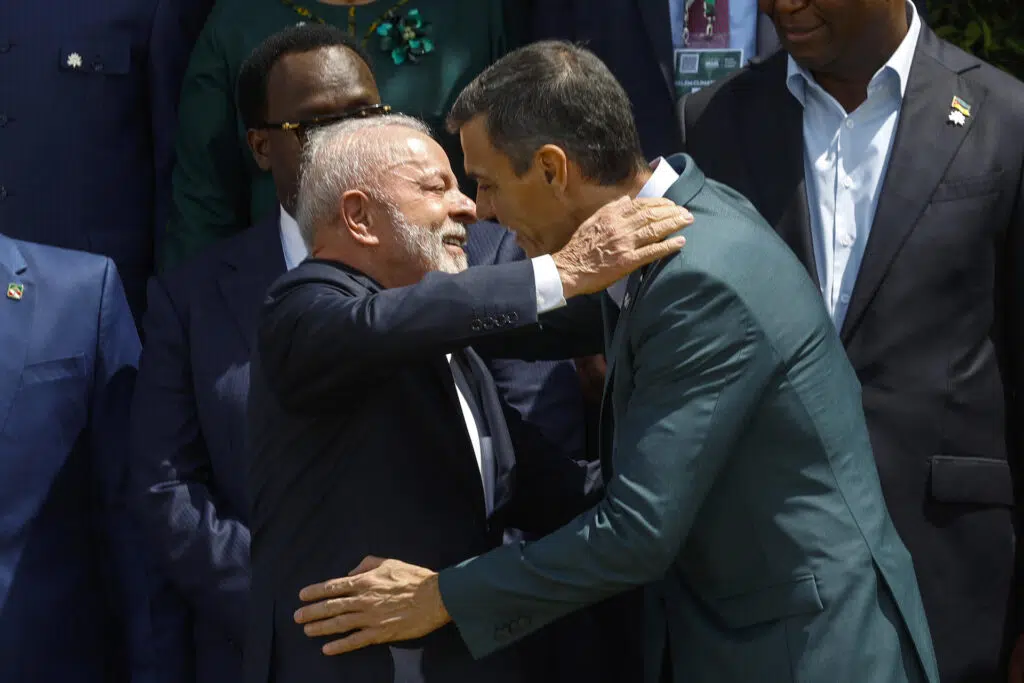A few days before the start of the COP30 climate summit in Belém, Brazil, the European Union (EU) achieved the necessary consensus to present its climate objectives there.
Environment ministers agreed to reduce greenhouse gas emissions by 90% by 2040.
The plan, long proposed by the European Commission, was approved in a last-minute meeting and will be presented at COP30.
These climate objectives serve as a basis to meet the emission reductions that the bloc must achieve by 2035 according to the Paris Agreement.
Thus, the EU seeks to reduce its emissions by 66.25% to 72.5% by 2035, taking 1990 levels as a reference.
This commitment marks a significant step in the fight against climate change.
 The president of Brazil, Luiz Inácio Lula da Silva (i), greets the president of the Government of Spain, Pedro Sanchéz (d) during the family photo on the last day of the COP30 leaders’ summit this Friday. Source: EFE.
The president of Brazil, Luiz Inácio Lula da Silva (i), greets the president of the Government of Spain, Pedro Sanchéz (d) during the family photo on the last day of the COP30 leaders’ summit this Friday. Source: EFE.
The new climate objectives of the EU, under the shadow of the Paris Agreement
In the 2015 Paris Agreement, world leaders committed to limiting the increase in global average temperature to below 2 degrees Celsius and maintaining it at 1.5 degrees.
Additionally, countries agreed to renew their climate objectives every five years.
However, the last deadline to present plans expired at the beginning of 2025.
And both the EU and other major emitters, including China, did not meet the established date for their climate objectives.
Meanwhile, emissions from the combustion of coal, gas, and oil continue to cause extreme changes in the climate.
This translates into increases in droughts, floods, storms, and extreme heat waves.

Alert at COP30: few countries presented their environmental objectives
To date, just over a third of the 195 countries have formally presented their climate objectives, including most of the EU.
This represents just over 60% of global emissions, according to analysts from the World Resources Institute (WRI).
The UN Secretary-General, António Guterres, stated that if the climate plans presented for 2035 are implemented, the projected temperature increase would be reduced from 2.6 degrees Celsius to 2.3.
“Current commitments still point to a climate collapse,” Guterres stated in a recent video.
And he added that it is “inevitable” to temporarily exceed 1.5 degrees.
However, the UN leader noted that this “is not a reason to give up,” but rather “to intensify efforts and accelerate the pace”. “
The goal of 1.5 degrees by the end of the century remains our main target,” he added.
Insufficient progress in the energy transition
“The transition is underway, progress is being made,” says Melanie Robinson, director of the global climate, economy, and finance program at the WRI.
She cites investment in solar energy, electric vehicles, and climate financing as examples.
However, Robinson warns that it is not happening with sufficient speed. “Leaders must agree on a decisive global response to get back on track,” she noted.
The expert suggests that countries should reaffirm the 1.5-degree goal, accelerate sectoral strategies for emission reduction, and clear the path to net-zero emissions.
